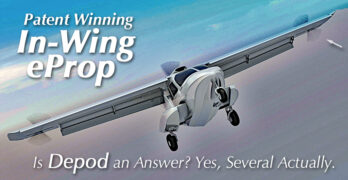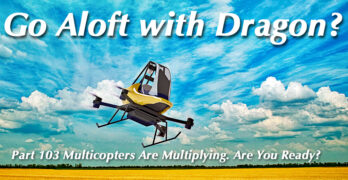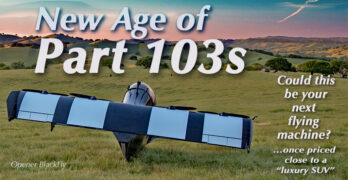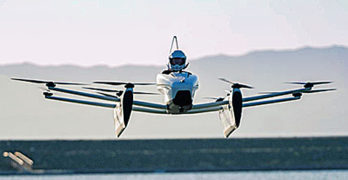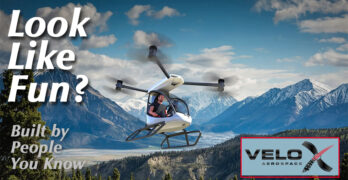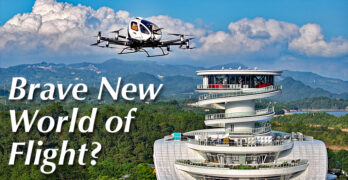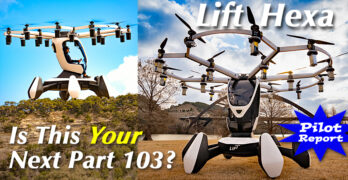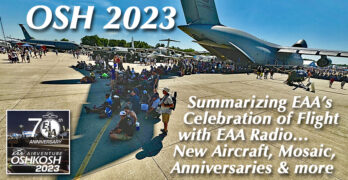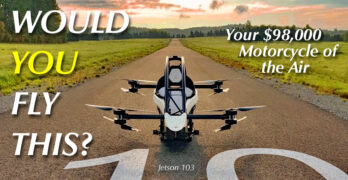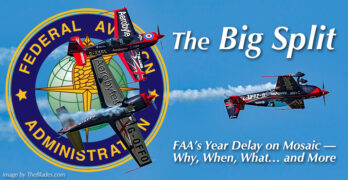Naturally, sharp-eyed ByDanJohnson.com readers already know about Chip’s big idea. See this article; scroll down.
What you didn’t know is that this idea was unique enough to win a patent. That’s uncommon in recreational aviation, though, of course, an idea like this may go far beyond sport flying.
Chip Erwin is one of those restless people who probably lays awake night cooking multiple ideas in his brain at the same time. Many industries have their “Elon Musk” type who moves forward on several fronts despite plenty of people telling him he can’t do what he does every day.
As the mainstream media hyperfocuses on multicopter air taxi ideas consuming vast amounts of money (why media pays attention in the first place), people like Chip have different thoughts about using electric power on aircraft. Depod is one of those concepts.
Depod is not intended for Merlin Lite.
Search Results for : multicopters
Not finding exactly what you expected? Try our advanced search option.
Select a manufacturer to go straight to all our content about that manufacturer.
Select an aircraft model to go straight to all our content about that model.
Air Taxi or Air Funster? — 5 Models in Development, as Part 103 Multicopters Not Taxis
If you listen to perpetually-excited media, air taxis will soon be shuttling people hither and yon in all the big cities of the globe. Executives and shoppers will be whisked around downtown skyscrapers silently, quietly, swiftly, and the cost will be modest. Do you buy all that? I’m not holding my breath.
Oh, these air taxi vehicles are coming. I don’t doubt that, if for no other reason than they are absorbing vast amounts of money as people bet on some grand future where infotech merges with aviation to make flying vastly better and easier. It’s a fantastic dream and when smart people powered by enough money work on something long enough… something often happens.
Fine. That’s the sales pitch and apparently it’s working because more than 350 companies around the globe have raised billions of dollars to pursue their dreams yet the first entries remain far from market.
Several people at the very pinnacle of FAA have departed the agency and are now working for air taxi developers (naturally, they are often called by some term other than the mundane “air taxi” label).
Invasion of the Part 103 Multicopters — Surveying 5 Entries, All “No Pilot License Required”
These new-millennia flying machines have inspired multiple names. While an eventual winner is determined, a common handle seems to be the rather awkward “eVTOL” — for electric vertical takeoff and landing. A range of abbreviations are also used: UAV, UAM, UAS, autonomous aircraft, and several others. I like multicopter — because all of them involved multiple propellers doing the lifting.
Most commonly, you hear “drone.”
Yet “drone” is further confusing because we haven’t separated crewed aircraft from uncrewed aircraft and this is a major distinction. FAA has also made this separation, so for this article, I will only speak of crewed aircraft, that is, a flying machine with a pilot using controls to direct its flight. In addition, I will also stick solely to single place aircraft that can theoretically qualify as a legitimate Part 103 ultralight vehicle.
Let me first extend a quick thanks to IEEE’s Spectrum magazine for making me aware of entries I’d missed.
Hmmm? How Can Duc Hélices Sell More Props? Hey, I Got It! …Multicopters!
Imagine you are in charge of marketing for French propeller manufacturer, Duc Hélices. The boss stops by your office and asks, “How are we going to sell more props?”
You begin to cite statistics (maybe even this website and its market share data). With more worldwide sales of LSA and LSA-like aircraft (chart), sales could be good, you say. Successful twin engine airplanes like Lockwood’s AirCam or Tecnam‘s Twin that swing two propellers per aircraft certainly add to sales. (Rotax enjoys this, too.)
Yet in the tech world, a 10% or 20% increase is nothing. Those hard-charging Silicon Valley companies have gotten used to things improving by orders of magnitude. “How can we increase sales by ten times,” demands the boss?
“Well, hmmm…” you thoughtfully reply, “I think I have an idea.”
Enter Multicopters
The little single place Kitty Hawk Flyer pictured above is one of several examples.
A Multicopter Current Pilots Might Enjoy? …Developed Within Our LSA Industry
Here’s a helicopter-like aircraft you might actually consider. I have often reviewed what I call multicopters (several articles). I searched for aircraft you might fly for fun; several of them can enjoy the freedom and special benefits of Part 103. I’ve stayed away from commercial “air taxi” projects.
But what if a longtime producer of Light-Sport Aircraft entered the space? What if the aircraft looked like a helicopter but one you could fly without the steep learning curve? What if it offered 45 minutes of flight with a 15-minute reserve?
The earliest entries had short flight times, 15-20 minutes. Most of them cost too much. For example, Opener’s Blackfly (now called Helix) was first promoted at the cost of a “luxury SUV,” perhaps meaning $80,000 at the time. It has since more than doubled in price.
You may doubt or dislike these flying machines, especially when you don’t know the people behind the projects.
Where Is the World Headed with Low-Altitude Airspace Freedom?
With the excitement of EAA’s summer celebration of flight — AirVenture Oshkosh 2024 — slowly beginning to fade from headlines, this might be a good time to broaden our outlook.
AirVenture features aircraft from everywhere and of every conceivable type. It’s a veritable smorgasbord of airplane-examining pleasure and thoroughly covers nearly every aspect of aviation, from foot-launched powered paragliders to multiengine warbirds and everything in between.
Some were searching for the newest innovations, by which such attendees may mean drones, UAVs, multicopters, eVTOLs… whatever you might choose to call them. Finding these machines at KOSH was much less obvious perhaps because the truth is, Yankee pilots remain focused on aircraft they can get in and fly using their own skills.
American Dream
We live in a country of great aviation freedom and lots of wide open spaces. Those of us interested in flying light aircraft for the sheer enjoyment of it can do so in way the rest of the world can barely comprehend.
LSA Pilot Review of a Multicopter: Lift Aircraft’s Part 103-Eligible Hexa
Ready or not, new flying machines are headed our way. Correction, they are already here and a wave of similar entries could follow (see earlier reports). The earliest market-ready arrivals qualify under FAR Part 103.
I believe this website needs to report these aircraft, so with pleasure, I announce the following to be perhaps the first multicopter pilot report from “one of us.” Scott Severen is a longtime LSA pilot, the importer of Jabiru aircraft, and the newly-elected President of LAMA, the Light Aircraft Manufacturers Association. Scott offers his impressions as one of the very first non-company pilots to fly one of these aircraft.
Some call them multicopters (me). Some prefer eVTOL. C’mon, have you said a mouthful like “eVTOL” to any non-pilot? …or even to most pilots? They look at you blankly, “Huh?” Marketers of these aircraft have yet to settle on a catchy word to identify them.
AirVenture Oshkosh 2023 Is Done; Here’s an Overview Done On-Air with EAA Radio
It’s all over — EAA AirVenture Oshkosh, the world’s largest-attendance airshow event. It’s a delicious, if somewhat overwhelming, drink out of a firehose for an entire week.
Oshkosh has something for every pilot and more than any one person can see.
I’ll mention this news briefly as I wish to pay respect to fellow pilots. Two crashes on the weekend after we departed resulted in four fatalities reportedly including one passenger. My sincere condolences to the surviving families. Oshkosh has had safe years with no loss of life but when so many airplanes assemble, mathematical odds suggest a crash is going happen despite heroic efforts to make the event as safe as possible.
During the week of Oshkosh, a few days were rather warm. Cooling rains came mostly at night, sparing the airshow but surely soaking campers in tents. The campgrounds were full to the edges and EAA opened multiple other locations to handle the overflow.
George Jetson Flying Machine — Now a Reality and a Qualifying Part 103 Ultralight?
Air taxis — eVTOLs — UAVs — UASs — UAMs. I like “multicopters,” but the name game continues.
Maybe these new-fangled flying contraptions have numerous (indecipherable) names because they’re still deciding which way they’re headed?
I believe aircraft like these are nearly inevitable and I not only don’t resist, I’m rather enthusiastic about them. I’d love to get picked up from my driveway and whisked by air to an appointment across town in minutes, free of clogged roads. C’mon, UberAir!
However, that dream may be years in the future. Oh, the technology is nearly ready now. It hasn’t been proven to be in-the-field robust yet but engineers know today most of what they need to make air taxis viable. Their much bigger challenge? Gaining public acceptance and winning regulatory approval. That could take a long time. Meanwhile…
What’s Here TODAY?!
Air taxis may be fuzzy in the distance but another class of these machines is nearly ready for market.
FAA’s Mosaic Rule — Delayed (a Year or More); Further Information about the New LSA Regulation
One of the most-read articles from my coverage of EAA AirVenture Oshkosh 2022 was the news that FAA missed their deadline as originally projected and will be a year or more late with the Mosaic rule. Many were upset at that result; others thought it was “par for the course.”
The good news, as I reported in the article, is that what emerges in one year will be a regulation that might actually go forward. Let me explain a little more fully.
During Oshkosh 2022, I attended three meetings where FAA spoke. I also had one-on-one discussions with several knowledgeable people. What follows is a fusion of all those conversations. While I believe this information to be accurate, the situation is changing and more questions will arise. Please consider this a snapshot in time.
The Main Question — As some commenters to the earlier article said, FAA did specify a date when the Mosaic NPRM may be released: “August 2023.” This came directly from David Boulter who was selected by the FAA Administrator to answer an audience question; the comment was made in a public forum.


